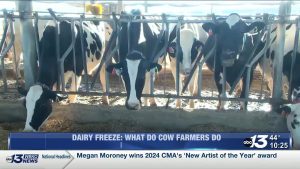- The quality of milk and milk products has continued to be a barrier to India’s entry to the export market, especially the EU and the USA, despite India being the largest producer of milk in the world.
- Indian exporters experience stringent safety standards under Technical Barriers to Trade (TBT) and Sanitary and Phytosanitary (SPS) measures in these markets.
- One of the reasons for this was lack of homogeneity in certification process. Taking note of this, the government has recently launched a unified logo and portal dedicated to the Conformity Assessment Scheme in Varanasi.
- This initiative will simplify the certification process and develop a quality culture in the dairy sector.
India’s dairy sector has witnessed a steady rise in milk production and per capita availability, taking India to the first position in terms of annual output. In 2019-20, India’s annual output stood at 198.40 million tonnes, a 5.68% rise from the 2018-19 figure of 187.75 million tonnes (Department of Animal Husbandry & Dairying, 2021). As the world’s largest producer of milk (FAO, 2021), its contributions to world milk production amounts to 23.10%. The major drivers of demand for this sector have been a growing population, urbanization, rise in disposable income levels, and altering food and lifestyle habits.
Indian dairy exports
With the phenomenal growth in dairy production since Operation Flood (1970-1996) and the accompanying reversal in the trend of trade balance in this segment, there are many challenges being faced by Indian dairy exporters. After the sharp rise in the y-o-y export growth rates in dairy amounting to 80.85% in 2018, a steady decline has been reported in the figures of -9.12% and -32.29% for 2019 and 2020 respectively. India’s average milk yield per cattle remains low as compared to developed countries. Technology infused infrastructural support such as mechanized milking systems and cold chain are found to be lacking. There is large domestic demand, and sporadic incidences of diseases affect cattle.
Further, with expanding global trade and increased consumption of better nutritional value foods and beverages, growing consumer awareness, globalization of tastes and preferences, and faster communication and transportation, quality and safety standards have become quite integral to international trade. In addition to consumers’ augmented quality consciousness, governments are also aggressively seeking to protect and safeguard its domestic population through the application of strict/stringent guidelines with respect to safety, health and environmental conditions. Entry into developed markets, therefore, continues to be a hurdle due to the imposition of high import tariffs and stringent safety standards under Technical Barriers to Trade (TBT) and Sanitary and Phytosanitary (SPS) measures. As the FAO suggests “quality of milk and milk products are a barrier to entry to the export market, especially the EU and the USA.”
Quality Mark & ISI Mark
On 23rd December 2021, PM Modi launched a unified logo and portal dedicated to the Conformity Assessment Scheme in Varanasi. As per the regulations notified under this scheme by the Bureau of Indian Standards (BIS), the scope has been defined as combining conformity of management systems to Indian Standards with the process requirements. The initiative was spearheaded by the Department of Animal Husbandry & Dairying, Government of India through an extensive consultations with stakeholders.
Prior to the launch of Conformity Assessment Scheme, both the National Dairy Development Board (NDDB) and Bureau of Indian Standards (BIS) were at the helm of process and product Certifications respectively. The NDDB was tasked with ensuring availability of safe and good quality milk and milk products for domestic and foreign consumption. It awarded the “Quality Mark” for milk and milk products as part of its quality and food safety initiative by laying down required processes for proper food safety and quality management systems with set quality parameters (compositional aspects, microbial parameters, and presence of contaminants). The dairy units, cooperative dairy organizations, and subsidiaries that are compliant to these norms are allowed to affix this logo on the milk and milk product packages with a validity of three years.
Under the ISI Mark Scheme, milk and milk related products are governed by the Food Safety and Standards regulations notified in 2011 which requires mandatory BIS certification. Under these regulations, provisions have been made regarding the manufacture or preparation of food for milk powder, condensed milk, skimmed milk powder, infant milk substitutes, and milk-cereal based weaning foods. The BIS licenses are awarded on the meeting the Indian Standard requirements with food safety management system compliance with IS/ISO 22000.
Product-Food Safety Management System-Process Certification
Through the Conformity Assessment Scheme, the unification of the NDDB and BIS certifications is expected to be a significant step towards simplifying the current certification process. This step is also envisioned to increase the awareness about quality standards among the public by employing a recognizable logo as a mark of conformity to high standards of quality, safety, health, and hygiene. It is also expected to increase the sales of milk and milk products in organized sector and in turn enhance income of farmers.
Currently, only 20% of the total milk production is procured by cooperatives and private dairies, 32% being sold in the unorganized market, and 48% being consumed locally. Organized sector handles only 40% of the milk sold while the remaining 60% is handled by the unorganized sector. In the face of a streamlined certification process in the dairy industry, there is greater scope for the unorganized milk output to be brought under the ambit of the formal sector.
Inclusion of small unorganized dairy producers will also facilitate the delivery of supporting schemes such as the Dairy Processing and Infrastructure Development Fund (DIDF) which disburses working capital loans to Dairy Cooperatives and Farmer Producer Organizations (FPOs). The focus of such schemes have been geared towards the expansion of processing technology that will enable value addition and increase production of higher value added products with greater avenues to earn higher levels of income.

















